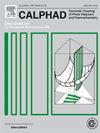Thermodynamic re-assessment of the Al-Li-Zn system
IF 1.9
3区 材料科学
Q4 CHEMISTRY, PHYSICAL
Calphad-computer Coupling of Phase Diagrams and Thermochemistry
Pub Date : 2024-09-28
DOI:10.1016/j.calphad.2024.102752
引用次数: 0
Abstract
Aluminum-lithium alloys are a kind of highly promising material due to low density, high strength and excellent modulus properties. The proper addition of Zn can effectively promote the precipitation of the main metastable strengthening phase δ′(Al3Li). As a crucial sub-system of Al-Li alloys, literature data on phase diagram and thermodynamic properties of the Al-Li-Zn system as well as the Al-Li and Li-Zn binary systems were comprehensively evaluated by the CALPHAD approach. The Li-Zn system was reassessed mainly by considering the newly reported data on formation enthalpy and activity and a 2-sublattice (SL) model was applied to describe the βLiZn4 phase. The Al-Li system was modified by considering AlLi2 and describing the metastable phase δ′(Al3Li) with interconvertible 4SL and 2SL ordered-disordered models. The predicted metastable fcc solvus was in perfect agreement with the measurements. Considering the available experimental data, the ternary Al-Li-Zn system was then re-optimized and a self-consistent thermodynamic description of the ternary Al-Li-Zn system was presented. The predicted metastable two-phase region of (Al)+δ’(Al3Li) in Al-Li-Zn system can be coupled with the accessible experimental data, which can be expected to well assist in designing high-strength Al-Li alloys.
铝-锂-锌体系的热力学再评估
铝锂合金具有低密度、高强度和优异的模量特性,是一种极具发展前景的材料。适当添加 Zn 能有效促进主要可转移强化相 δ′(Al3Li)的析出。作为铝锂合金的一个重要子系统,我们采用 CALPHAD 方法全面评估了铝锂锌体系以及铝锂和锂锌二元体系的相图和热力学性质的文献数据。主要通过考虑新报道的形成焓和活性数据对锂锌体系进行了重新评估,并应用 2 子晶格(SL)模型描述了 βLiZn4 相。通过考虑 AlLi2 并用可相互转换的 4SL 和 2SL 有序-无序模型来描述δ′(Al3Li)逸散相,对 Al-Li 系统进行了修改。预测的可逸散共晶溶解度与测量结果完全一致。考虑到现有的实验数据,对三元 Al-Li-Zn 体系进行了重新优化,并提出了三元 Al-Li-Zn 体系的自洽热力学描述。所预测的 Al-Li-Zn 系统中 (Al)+δ'(Al3Li) 的可蜕变两相区可与可获得的实验数据相结合,从而有望为设计高强度 Al-Li 合金提供很好的帮助。
本文章由计算机程序翻译,如有差异,请以英文原文为准。
求助全文
约1分钟内获得全文
求助全文
来源期刊
CiteScore
4.00
自引率
16.70%
发文量
94
审稿时长
2.5 months
期刊介绍:
The design of industrial processes requires reliable thermodynamic data. CALPHAD (Computer Coupling of Phase Diagrams and Thermochemistry) aims to promote computational thermodynamics through development of models to represent thermodynamic properties for various phases which permit prediction of properties of multicomponent systems from those of binary and ternary subsystems, critical assessment of data and their incorporation into self-consistent databases, development of software to optimize and derive thermodynamic parameters and the development and use of databanks for calculations to improve understanding of various industrial and technological processes. This work is disseminated through the CALPHAD journal and its annual conference.

 求助内容:
求助内容: 应助结果提醒方式:
应助结果提醒方式:


